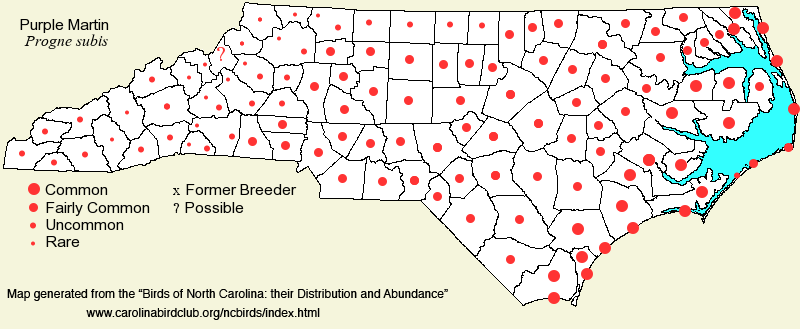 |  |
|
Purple Martin - Progne subis HIRUNDINIDAE Members: | Search Common: Search Scientific: |
|
|
|||||||
| General Comments | Probably no bird in the United States relies on man as does the Purple Martin. Prior to man providing them homes with bird houses and gourds, these largest of our swallows nested in tree cavities. Martins no longer nest away from man; essentially all nest in man-made structures. Another fascinating feature of martins is their time of residency in the states. They often arrive in North Carolina by late Feb, well before the last of the sub-freezing temperatures, making foraging on flying insects sometimes a challenge. And, they gather after breeding into a few huge flocks of tens of thousands of birds, heading southward before the end of Aug, though some are seen into Sep. Birds are practically never seen in the state from Oct through Jan. Martins nest over nearly all of the state, except in the higher mountains; their habitat is dependent on where houses and gourds are placed. Favored areas contain much open country, such as farmyards and pastures, and a lake or pond is always a bonus. Sadly, the species has shown a decline in the state, especially as a breeder, and birds often are not arriving now until Mar. | ||||||
| Breeding Status | Breeder | ||||||
| NC BRC List | Definitive | ||||||
| State Status | |||||||
| U.S. Status | |||||||
| State Rank | S5B | ||||||
| Global Rank | G5 | ||||||
| Coastal Plain | Summer resident, somewhat declining. Generally common in the eastern portions -- near the coast and in Tidewater; generally fairly common, to locally common, over most of the inner portions. There is a post-breeding concentration of up to about 40,000 birds for a few weeks (late Jul to mid-Aug) that roost under the old US 64 bridge over Croatan Sound, near Manns Harbor (Dare). Mainly early Mar to early or mid-Sep. One female at Pea Island NWR on 18 Nov 1979 was exceptionally late. Peak counts: [no data yet for the Croatan Sound flock sizes]; 7,000, Fayetteville, 24 Jul 1987. | ||||||
| Piedmont | Summer resident, declining. Fairly common on the whole for the region, but in reality it is variously locally uncommon to locally common, depending on locations and abundance of suitable martin boxes and gourds. Mainly early Mar to mid-Aug, rarely into Sep. One photographed at Jordan Lake (Chatham) on 8 Oct 2023 was very late, as there is hardly any state documentation after Sep. Peak counts: 200,000 estimated at a roost in Greensboro (date not given, but pre-1942); 40,000, roosting at the Unifi Plant in Yadkinville (Yadkin), 6 Aug 2014; 3,000, Durham, 23 Jul 1970. | ||||||
| Mountains | Summer resident. Generally uncommon to locally fairly common at low elevations, up to about 3,000 feet. Quite scarce above 3,000 feet, and probably absent above 4,000 feet. Migrants can occur at higher elevations. Mainly late Mar to mid- or late Aug. Peak counts: | ||||||
| Finding Tips |
Usually easy to find on the Outer Banks in the early summer. The birds are not "miss-able" at the old US 64 Croatan Sound bridge in early August. **** | ||||||
| Attribution | LeGrand[2024-02-10], LeGrand[2023-03-26], LeGrand[2015-09-06] | ||||||
| NC Map Map depicts all counties with a report (transient or resident) for the species. | Click on county for list of all known species. |
| NC Breeding Season Map Map depicts assumed breeding season abundance for the species. |  |